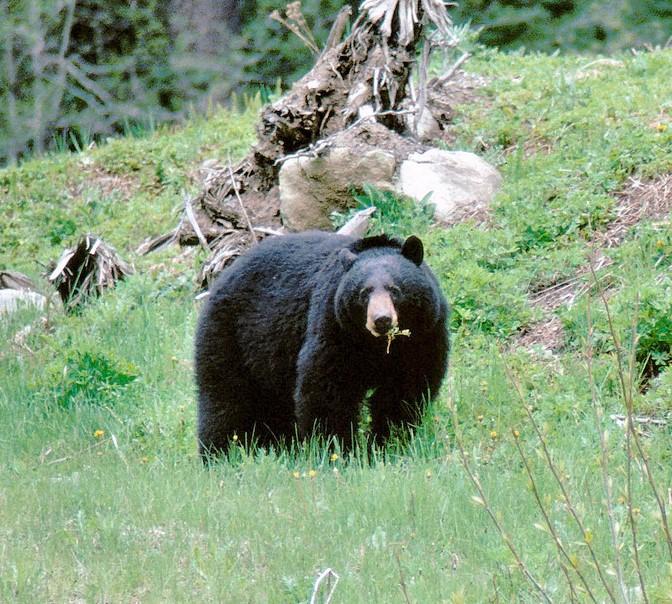American black bears are the most common and widely distributed bears in North America and occur throughout most of Washington with the exception of the Columbia Basin. Grizzly bears also occur in Washington, but populations are currently limited to Northeast Washington. Both species are well known for the excellent sense of smell, winter hibernation, and large appetites.
Black bears are generalist omnivores and primarily eat a variety of plants and plant parts such as berries and nuts. Black bears will also prey and scavenge upon animals such as insects, mammals, fish, and birds. In this way they are crucial seed dispersers and recycle nutrients throughout ecosystems.
As human populations encroach on bear habitat, people and bears have greater chances of encountering each other. Bears usually avoid people, but conflicts can arise especially when black bears become habituated to human-provided food sources. All bears should be given plenty of respect and room to retreat without feeling threatened. The best way to not have interactions with bears at home is to remove food that provide bears with a high amount of calories. This includes leaving garbage cans in garages or using bear resistant containers, removing bird feeders (including liquid hummingbird feeders), keeping fruit trees picked, and keeping small livestock like chicken and goats in secure enclosures with a roof.
Description and Range
Physical description
Despite their name, black bears may be a variety of colors, including black, brown, blond, cinnamon, and rust, or any combination thereof. Black or brown, with a light brown snout, is the most common coloration.
On average, black bears in Washington weigh 100-300 pounds, with males larger than females. They stand approximately 2.5-3 feet at the shoulder when standing on all fours, and about 5 feet when standing upright. When on all fours, the black bear's rump is higher than its shoulders.
The black bear's face profile is straight, with a relatively long muzzle and long, prominent ears.
Geographic range
Black bears are common—including in suburban areas where greenbelts facilitate movement—throughout Washington except the interior of the arid Columbia Basin. Based on the latest data, WDFW estimates that there are approximately 22,000 black bears in Washington across all land ownerships. This estimate accounts for all ages of black bears, including cubs.
Black bears live in a diverse array of forested habitats in the state, from coastal rainforests to the dry woodlands of the Cascades’ eastern slopes. In general, black bears are strongly associated with forest cover, but they do occasionally use relatively open country, such as clear cuts and the fringes of other open habitat.
Regulations
Licenses and permits
To hunt bear in Washington, you must purchase a big-game license that includes bear. For pricing and more information, see the hunting licenses page.
Species identification
Washington is home to both grizzly bears and black bears. Grizzly bears are rare in Washington, but there is a small population in the Selkirk Mountains of northeast Washington, and their presence has been documented in the Okanogan Highlands and the North Cascades. Watch our video about identifying grizzly bears versus black bears in the field.
Hunters in certain GMUs are required to successfully complete the WDFW bear identification test, or equivalent test from another state, to avoid potential misidentification of grizzly bears by black bear hunters. The bear ID test is required in GMUs 101, 105, 108, 111, 113, 117, 121, 203, 204, 209, 215, 218, 224, 231, 242 - 244, 418, 426, 437, and 450 and you must carry proof of successful completion. The bear identification test is now available in WDFW's WILD system. Hunters must login with their username and password and click the "Mandatory Species Identification Tests" link.
Hunters who purchase their bear license and tag will need to take the test if they choose to hunt in the identified GMUs.
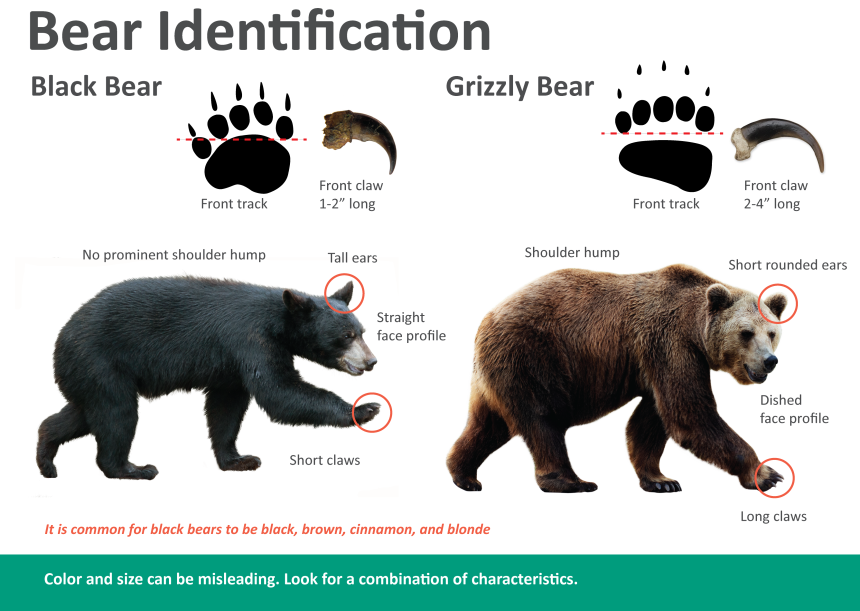
Identifying the sex of a black bear while hunting
It is illegal to shoot a cub, or a female with cubs. During the fall season, females may be accompanied by cubs weighing 30-50 lbs. Cubs tend to lag behind when traveling, so please observe and be patient before shooting. Watch the video below to learn more about identifying the sex of a black bear while hunting.
Rules and seasons
View the big game hunting regulations for a summary of fall black bear hunting seasons.
Tooth submission requirements
All successful black bear hunters must submit the complete, unbroken root of the first premolar tooth from their harvest per WAC 220-415-090. Teeth should be sent using WDFW's pre-paid and self-addressed mortality envelope which can be obtained in-person or by calling any WDFW office.
WDFW uses teeth to get an accurate age of harvested bears. Hunters wanting to check the age of their harvested bear can visit the following tooth age lookup webpage. Teeth are aged by an external laboratory and the turnaround time for age results can be up to six months after the close of the fall big game hunting season.
Living with wildlife
Learn more about coexisting with black bears by reviewing the resources under the "Resources" tab.
Tracks
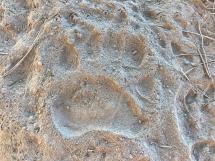
All black bear prints usually show five digits. The toes form a rough semicircle in front of each foot, with the middle toe being the longest. Front foot tracks have small footpads, whereas hind foot tracks characteristically show an extended footpad, resembling a human foot. The claw marks are about ½ inch in front of the toe pads, but often the claw marks do not show in a track.
Droppings
When plants, insects, and animal carcasses make up most of a bear’s diet, its droppings are cylindrical and typically deposited in a coiled form, sometimes in individual segments. Segments are 2 to 3 inches long and 1¼ to 1½ inches in diameter. Bits of hair, fur, bone, insect parts, and plant fibers distinguish these droppings from human feces, as does the large size of the deposit. Color ranges from dark brown to black, and when grasses are being heavily eaten droppings are often green. When fruits and berries are in season, droppings assume a moist, “cowpie” form and seeds are visible.
Bear trees
Black bears commonly leave a variety of marks on trees. Because young bears often climb trees, trees in high bear density habitats will show the telltale claw marks and hairs indicating that a bear has previously climbed the tree.
On young conifers, particularly Douglas-fir trees, bears will rip strips of bark off with their teeth to reach
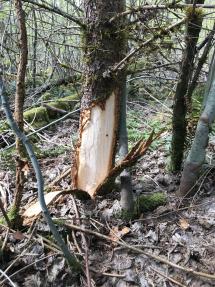
insects or the sweet-tasting sap found inside. The bear’s teeth leave long vertical grooves in the sapwood and large strips of bark are found around the bases of trees they peel. These marks are typically made from April to July, but the results may be seen all year. This foraging activity is common in tree plantations where large stands of trees are similarly aged and of a single species.
A bear may also rub its back against a tree or other object. Rubbing is a favorite summer pastime among black bears, relieving the torment of parasites and loosening their thick, matted winter coat. Good scratching trees may be used repeatedly for several years, and are easily identified by the large amounts of long black or brown fur caught in the bark and sap. Rough-barked trees often serve as rubbing posts.
It has been debated whether bears mark trees to convey social information akin to territorial marking in other carnivores. Such marks are most easily seen on smooth-barked species of trees—alder, aspen, birch, and white pine—on which tooth and claw marks will contrast most visibly, but any live or dead standing trees may be heavily chewed. Human structures such as utility poles, footbridges, and even outbuildings may also be chewed.
Preventing conflict
If you are recreating in bear country, always remember: Never travel alone, keep small children near you at all times, and always make your presence known—simply talking will do the trick. Most experts recommend carrying bear spray when recreating in areas where bears or other potentially dangerous wildlife may be present. A bear spray that has a capsaicin (pepper) content between 1.3 and 2 percent can be an effective deterrent to an aggressive bear if it is sprayed directly into the bear’s face within 6 to 10 meters (20-30 feet).
Learn more about preventing conflict with black bears by reviewing the resources under the "Resources" tab.
Preventing conflicts
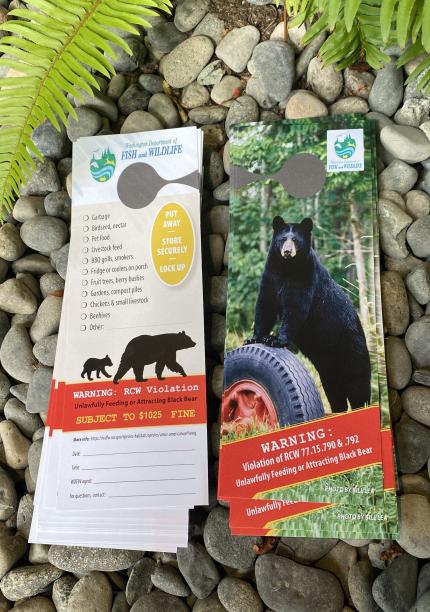
State wildlife offices receive hundreds of black bear complaints each year regarding urban sightings, property damage, attacks on livestock, and bear/human confrontations.
The number one reason for conflict (95% of the calls to offices) is the result of irresponsibility on the part of people: access to trash, pet food, bird feeders, and improper storage of food while camping make up the majority of the calls.
Bears may opportunistically seek food in human-occupied areas when natural foods are scarce. This occurs annually in early spring before natural foods become available and in late fall as bears prepare for hibernation. Additionally, in some years a late-arriving spring or drought conditions may increase the likelihood of this behavior.
If you live in areas where black bears are seen, use the following strategies around your property to prevent conflicts:
Don’t feed bears. Often people leave food out for bears so they can take pictures of them or show them to visiting friends. Over 90 percent of human-bear conflicts result from bears being conditioned to associate food with humans. A wild bear can become permanently food-conditioned after only one handout experience. The unintended reality is that these bears will likely die, being killed by someone protecting their property, or by a wildlife manager having to remove a potentially dangerous bear.
Manage your garbage. Bears will expend a great amount of time and energy digging under, breaking down, or crawling over barriers to get food, including garbage. If you have a pickup service, put garbage out shortly before the truck arrives—not the night before. If you’re leaving several days before pickup, haul your garbage to a dump. If necessary, frequently haul your garbage to a dumpsite to avoid odors.
Keep garbage cans with tight-fitting lids in a shed, garage, or fenced area. Spray garbage cans and dumpsters regularly with disinfectants to reduce odors. Keep fish parts and meat waste in your freezer until they can be disposed of properly.
If bears are common in your area, consider investing in a commercially available bear-resistant garbage container. Ask your local waste management company if bear-resistant garbage containers are available or if individually purchased containers are acceptable and compatible with their equipment.
For more information about how to prevent human-bear conflict around your home and small livestock as well as bear safety tips while hiking, camping, or hunting visit bearwise.org
Bear attacks
Avoiding bear encounters, using the advice above, is the best way to prevent negative interactions between people and bears. Although bear attacks are rare, anytime you are in bear habitat you should know what to do should an encounter occur. Here are tips should you come in close contact with a black bear:
- Stop, remain calm, and assess the situation. If the bear seems unaware of you, move away quietly when it’s not looking in your direction. Continue to observe the animal as you retreat, watching for changes in its behavior.
- If a bear walks toward you, identify yourself as a human by standing up, waving your hands above your head, and talking to the bear in a low voice. If you have bear spray, get it out of the holster and remove the safety.
- If you cannot safely move away from the bear or a black bear continues toward you, scare it away by clapping your hands, stomping your feet, and yelling. If you are in a group, stand shoulder-to shoulder and raise and wave your arms to appear intimidating. The more a black bear persists the more aggressive your response should be. If you have bear spray, use it.
- Do not run from the bear. Bears can run up to 35 mph and running may trigger an attack. Climbing a tree is generally not recommended as an escape from an aggressive black bear, as black bears are adept climbers and may follow you up a tree.
In the unlikely event a black bear attacks you (where actual contact is made), fight back aggressively using your hands, feet, legs, and any object you can reach. Aim for the eyes or spray bear spray into the bear’s face.
Resources
Brochures
Flyers
Blogs
- Do your part to keep bears wild by cleaning up backyard attractants
- Why can’t more black bears be relocated following conflicts?
Videos
BearWise® materials
WDFW partners with BearWise to help share sound information and smart solutions that help homeowners, businesses and communities coexist with bears.
At home
- How BearWise are you? (PDF)
- Stash, latch, secure your trash (PDF)
- Electric fences keep bears out (PDF)
- Attract birds, not bears (PDF)
- Six at-home BearWise basics (PDF)
Outdoors
- How to use bear spray
- Outdoor safety tips (PDF)
- Dogs + bears = problems (PDF)
- Six outdoor BearWise basics (PDF)
